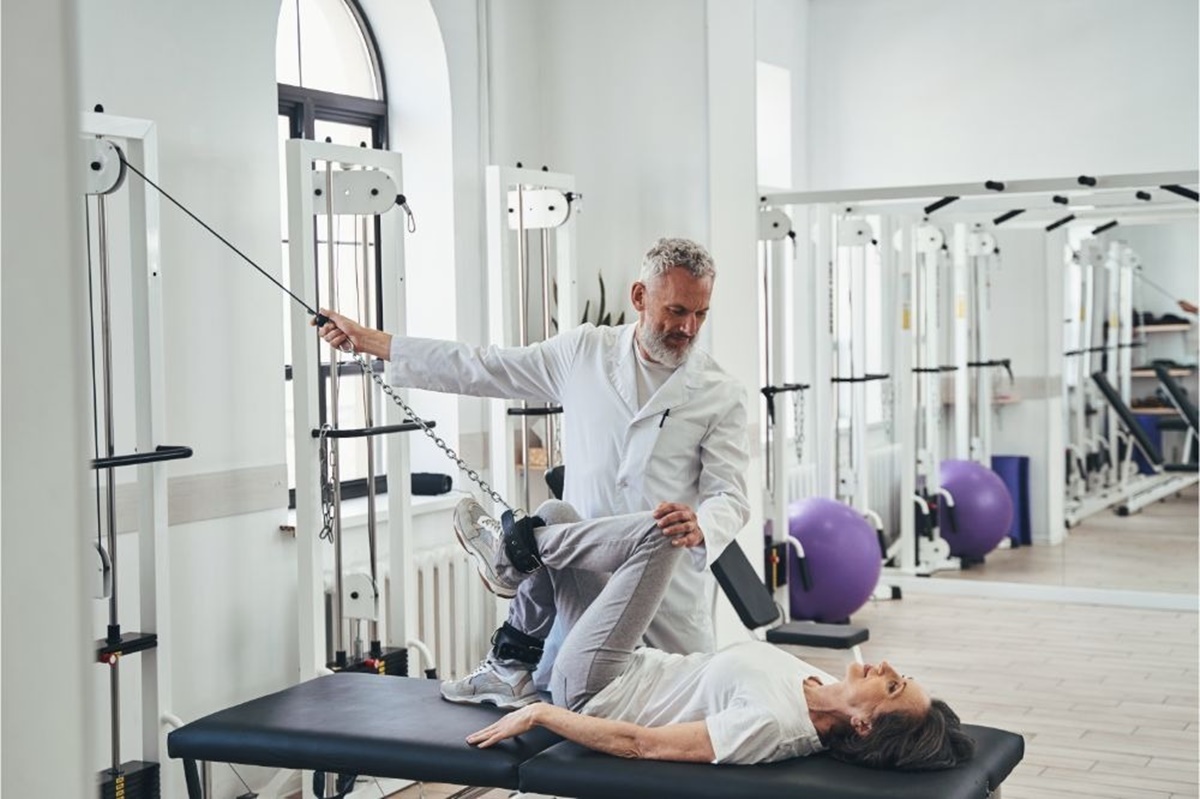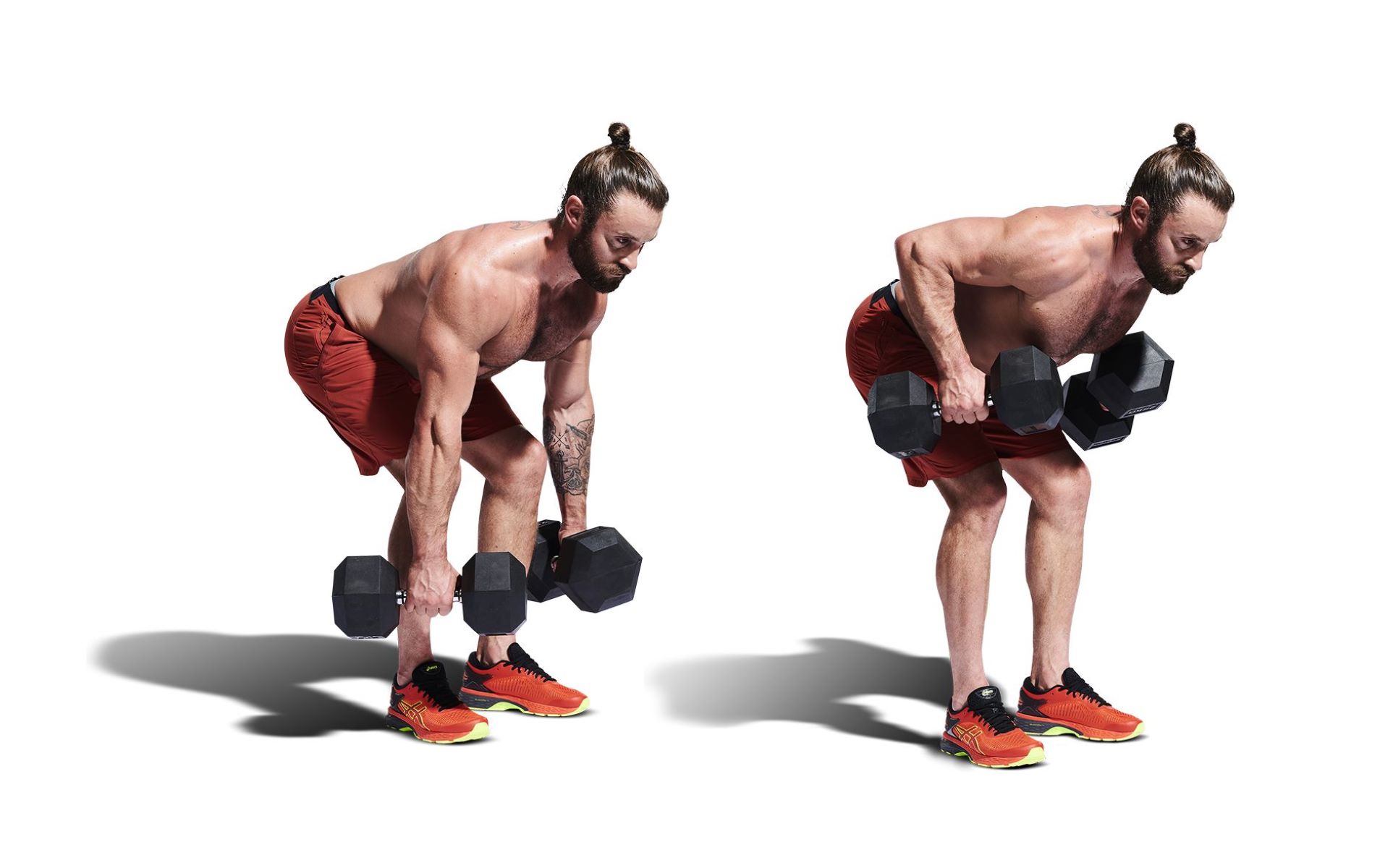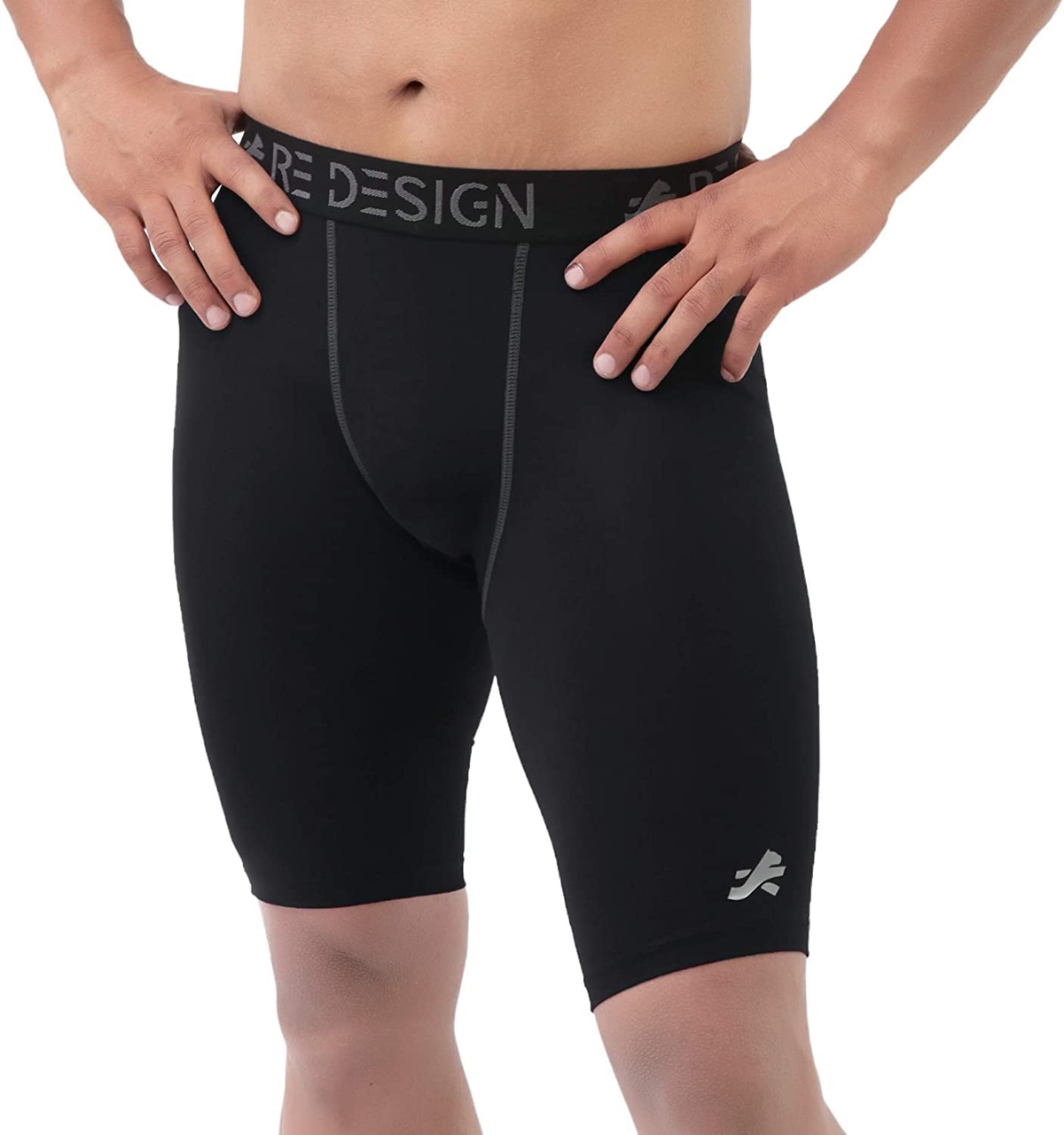Home>Misc>Featured>What Is The Best Exercise Machine For Bad Knees?


Featured
What Is The Best Exercise Machine For Bad Knees?
Modified: January 2, 2024
Find out the featured exercise machine for bad knees that will help you stay active and fit without putting strain on your joints.
Introduction
Are you one of the millions of people suffering from knee pain? It can be quite frustrating when this pain limits your ability to engage in physical activities. However, if you’re looking to stay active despite having bad knees, there is still hope. One of the best ways to maintain an active lifestyle while accommodating your knee condition is by using exercise machines specifically designed for people with knee issues.
In this article, we will explore the best exercise machines for bad knees and how they can help alleviate pain and improve joint mobility. Whether you’re recovering from an injury, managing chronic pain, or simply looking for low-impact exercise options, these machines are worth considering.
Before we delve into the specific machines, it’s important to understand the common causes of knee pain. Knee pain can be the result of various factors such as arthritis, overuse injuries, ligament damage, or muscular imbalances. It is crucial to get a proper diagnosis from a healthcare professional to determine the underlying cause of your knee pain and to develop an appropriate exercise plan.
Once you have a clear understanding of your knee condition, you can choose an exercise machine that suits your needs. When selecting a machine, there are several key factors to consider, including low-impact exercises, range of motion, joint support, adjustability, and overall comfort. These factors will help ensure that you find a machine that supports your knees and allows you to exercise safely and effectively.
Understanding Knee Pain
Knee pain can range from mild discomfort to debilitating agony, and it is a common complaint among people of all ages. Understanding the causes and types of knee pain is vital to effectively manage and treat the condition.
There are numerous factors that can contribute to knee pain. One of the most prevalent causes is osteoarthritis, which occurs when the protective cartilage in the joints begins to wear down over time. This can result in pain, stiffness, and swelling in the knee joint. Other conditions such as rheumatoid arthritis, gout, and bursitis can also cause knee pain.
Injuries are another common source of knee pain. Sports-related injuries, accidents, and falls can lead to sprains, strains, torn ligaments, or meniscus tears. These injuries often result in immediate pain and may require medical intervention for proper healing.
Poor biomechanics or alignment issues can also contribute to knee pain. When the knees are not properly aligned or the surrounding muscles are imbalanced, excessive stress is placed on certain areas of the knee joint, leading to pain and discomfort over time.
Excessive weight can also put extra strain on the knees, leading to pain and inflammation. Losing weight can help alleviate knee pain and reduce the risk of developing chronic knee conditions.
To effectively manage knee pain, it is crucial to receive a proper diagnosis from a healthcare professional. They will conduct a thorough examination, which may include imaging tests such as X-rays or MRI scans, to determine the cause of the pain. Once a diagnosis is made, an appropriate treatment plan can be developed.
Treatment options for knee pain may include physical therapy, pain medication, corticosteroid injections, or in severe cases, surgery. Alongside these treatments, incorporating regular exercise into your routine can help strengthen the muscles surrounding the knee, improve flexibility, and reduce pain.
However, it’s essential to choose exercises and workout equipment that are safe and supportive for individuals with knee pain. Utilizing exercise machines specifically designed for bad knees can help minimize the impact on the joints while providing an effective workout.
Factors to Consider for Exercise Machines
When selecting an exercise machine for bad knees, there are several factors to take into consideration. These factors will ensure that you choose a machine that is safe, effective, and supportive for your knee condition.
- Low-impact exercises: Opt for machines that offer low-impact exercises, such as cycling or swimming. These exercises minimize stress on the knee joints while providing cardiovascular benefits.
- Range of motion: Look for machines that allow you to adjust the range of motion to suit your comfort level. Being able to control the range of motion can help prevent any excess stress on the knees.
- Joint support: Choose machines that provide proper support and cushioning for the knees. Look for features like padded seats and adjustable handlebars for optimal comfort.
- Adjustability: Make sure the machine is easily adjustable to accommodate your body’s unique dimensions. This will ensure proper alignment and reduce the risk of developing further knee pain or discomfort.
- Overall comfort: Consider the overall comfort of the machine, including factors such as seat padding, handlebar grip, and ease of use. The more comfortable the machine, the more likely you are to stick with your exercise routine.
In addition to these factors, it’s important to listen to your body and pay attention to any discomfort or pain during your workouts. If you experience any pain, stop the exercise and consult with a healthcare professional.
Remember that everyone’s knee pain is unique, and what works for one person may not work for another. It’s essential to find an exercise machine that caters to your specific needs and limitations. Consulting with a physical therapist or an exercise specialist can provide valuable guidance in choosing the most suitable exercise machine for your bad knees.
By considering these factors when selecting an exercise machine, you can find a safer and more supportive option that allows you to stay active and maintain overall fitness without worsening your knee pain.
Best Exercise Machines for Bad Knees
When it comes to choosing the best exercise machines for bad knees, there are several options that can provide a low-impact, joint-friendly workout. These machines are designed to minimize stress on the knees while still providing a challenging and effective workout. Here are five of the best exercise machines for bad knees:
- Stationary Bike: A stationary bike is an excellent option for individuals with bad knees. It offers a low-impact workout that strengthens the muscles surrounding the knee joint without putting excessive strain on the knees. Look for a bike with an adjustable seat and resistance levels to customize your workout intensity.
- Elliptical Trainer: An elliptical trainer is another great choice for individuals with knee pain. This machine mimics the motion of running without the impact on the joints. The smooth, gliding motion of the elliptical helps reduce stress on the knees, making it a safe and effective option for cardiovascular exercise.
- Rowing Machine: A rowing machine provides a full-body workout while being gentle on the knees. It engages the upper and lower body, improving strength and cardiovascular fitness. The fluid motion of rowing helps minimize impact and allows for a challenging workout without aggravating knee pain.
- Water Aerobic Machine: Water aerobics is an excellent low-impact exercise option for individuals with knee pain. These machines, such as water ellipticals or treadmills, allow you to perform cardio workouts in a pool. The buoyancy of the water reduces the strain on the knees while providing resistance for a challenging workout.
- Treadmill with Cushioning: If you enjoy walking or jogging, a treadmill with cushioning is a good option for individuals with bad knees. Look for treadmills that offer shock absorption or adjustable cushioning to reduce the impact on the knees. Start slow and gradually increase the intensity to avoid any knee discomfort.
Remember to start your workouts at a comfortable intensity and gradually increase as your fitness levels improve. It’s important to listen to your body and modify exercises as needed to avoid any unnecessary strain on your knees.
While these exercise machines are generally safe for individuals with bad knees, it’s always a good idea to consult with a healthcare professional if you have any concerns or specific limitations. They can provide personalized recommendations based on your unique knee condition.
By incorporating these exercise machines into your fitness routine, you can enjoy the benefits of regular physical activity while minimizing the impact on your knees. Stay consistent, and over time, you may notice an improvement in knee pain and overall joint mobility.
Stationary Bike
A stationary bike is an excellent exercise machine for individuals with bad knees. It offers a low-impact workout that helps strengthen the muscles surrounding the knee joint without putting excessive stress on the knees themselves.
One of the major benefits of using a stationary bike is the adjustability it offers. Most stationary bikes have adjustable seat height and handlebar positions, allowing you to find a comfortable and proper riding posture that aligns with your knee joint. This helps reduce strain on the knees and ensures proper form during your workout.
Additionally, stationary bikes provide a cardiovascular workout that helps improve endurance and burn calories. By pedaling on a stationary bike, you can engage your leg muscles, including the quadriceps and hamstrings, without putting excessive pressure on the knee joint. This makes it an ideal exercise machine for people with knee conditions such as osteoarthritis or recovering from knee surgeries.
When using a stationary bike, start with a low resistance setting and gradually increase as your knee strength improves. This allows you to build endurance and muscle strength without causing unnecessary discomfort or worsening your knee pain. It’s also important to maintain a steady pedaling motion and avoid bouncing or jerking movements to minimize stress on the knees.
Using a stationary bike regularly can have multiple benefits for individuals with bad knees. It can help improve joint flexibility and range of motion, increase muscle strength, and promote overall cardiovascular fitness. Additionally, it can be a convenient and accessible option for exercising, as stationary bikes are available in many fitness centers or can be purchased for home use.
It’s important to note that if you have severe knee pain or have undergone recent knee surgery, it’s advisable to consult with a healthcare professional or physical therapist before starting an exercise routine on a stationary bike. They can provide guidance on proper form, intensity, and duration of workouts based on your specific knee condition.
Incorporating a stationary bike into your workout regimen can be an effective way to stay active and maintain overall fitness while accommodating your bad knees. Give it a try and experience the benefits of low-impact cardio exercise with minimal strain on your knee joints.
Elliptical Trainer
An elliptical trainer is another excellent exercise machine for individuals with bad knees. This machine provides a low-impact workout that mimics the motion of running without the jarring impact on the joints, making it a safe and effective option for cardio exercise.
The elliptical trainer works by simulating a walking or running motion, but with your feet remaining in constant contact with the pedals. This smooth and gliding motion helps reduce stress on the knees, making it an ideal choice for those with knee pain or knee conditions such as arthritis.
One of the major benefits of using an elliptical trainer is the ability to adjust the resistance and incline levels. This allows you to customize the intensity of your workout to suit your fitness level and knee capabilities. Starting with a lower resistance level and gradually increasing as your knees become stronger can help prevent any unnecessary strain.
Furthermore, an elliptical trainer engages both the upper and lower body, providing a full-body workout. By using the handles and pushing and pulling motions, you can engage your chest, back, shoulders, and arms while simultaneously working the muscles in your legs and glutes. This comprehensive workout helps improve muscle strength and cardiovascular fitness without putting excessive stress on the knees.
When using an elliptical trainer, it’s important to maintain proper form by keeping your feet flat on the pedals and your knees slightly bent throughout the motion. Avoid leaning forward or putting excessive pressure on the handles, as this can strain the upper body and take away from the lower body workout.
As with any exercise machine, it’s important to start slowly and gradually increase the intensity and duration of your workouts. This allows your knees to adapt and build strength over time. Listening to your body and taking breaks as needed is crucial to prevent overexertion and protect your knee joints.
If you have severe knee pain or have recently undergone knee surgery, it’s recommended to consult with a healthcare professional or physical therapist before using an elliptical trainer. They can provide guidance on proper form, appropriate resistance levels, and workout duration to accommodate your specific knee condition.
Incorporating an elliptical trainer into your exercise routine can be a fantastic way to get a low-impact, full-body workout while minimizing strain on your knees. Enjoy the benefits of cardiovascular exercise, improved muscle strength, and overall fitness without compromising your knee health.
Rowing Machine
A rowing machine, also known as an ergometer or rower, provides a full-body workout while being gentle on the knees. This machine engages both the upper and lower body, making it an excellent exercise option for individuals with bad knees.
The rowing machine offers a low-impact workout that helps improve cardiovascular fitness, muscle strength, and endurance. It mimics the motion of rowing a boat, with a sliding seat and handles attached to a resistance system. This low-impact motion reduces stress on the knees while still delivering a challenging workout.
One of the key benefits of using a rowing machine is that it engages multiple muscle groups simultaneously. By properly using your legs, core, back, and arms during each stroke, you can distribute the workload and reduce strain on the knees. This makes it an ideal exercise machine for individuals with knee conditions or those recovering from knee injuries.
Additionally, rowing is a non-weight-bearing exercise, meaning it doesn’t put extra pressure on your joints. This can be particularly beneficial for individuals who are overweight or have arthritis, as it allows them to engage in a full-body workout without exacerbating knee pain or discomfort.
When using a rowing machine, it’s important to maintain proper form to ensure a safe and effective workout. Sit up tall, keep your back straight, and engage your core muscles throughout the rowing motion. As you push off with your legs and pull the handle towards your chest, aim to maintain a smooth and controlled movement to minimize any sudden or jerking motions that can strain your knees.
Start with a low resistance setting and gradually increase as your knees become stronger and more accustomed to the exercise. It’s important to listen to your body and avoid overexertion or pushing through pain. Taking breaks when needed and gradually increasing your workout duration and intensity will help protect your knee joints while still reaping the benefits of rowing.
If you have any concerns about using a rowing machine due to your knee condition, it’s recommended to consult with a healthcare professional or physical therapist. They can provide guidance on proper technique, suitable resistance levels, and a workout plan that accommodates your specific knee condition.
Incorporating a rowing machine into your fitness routine can provide a full-body, low-impact workout that strengthens your muscles and improves cardiovascular fitness. Enjoy the benefits of rowing while minimizing stress on your knees and maintaining your overall knee health.
Water Aerobic Machine
Water aerobic machines provide an excellent low-impact exercise option for individuals with bad knees. These machines allow you to perform cardio workouts in a pool, taking advantage of water’s buoyancy to reduce strain on the knees while still providing resistance for a challenging workout.
One of the primary benefits of water aerobic machines is the buoyancy of water. It supports your body weight, reducing the impact on your joints, including the knees. This makes it an ideal choice for individuals with conditions such as arthritis, as well as those recovering from knee injuries or surgeries.
Water aerobic machines come in various forms, such as water ellipticals or treadmills. These machines allow you to perform exercises similar to their land-based counterparts, but with the added benefits of water resistance and reduced impact.
Water ellipticals provide a smooth gliding motion, simulating the movement of an elliptical trainer on land. The water resistance adds a challenging element to your workout, helping to strengthen muscles and improve cardiovascular fitness without stressing the knees.
Water treadmills, on the other hand, allow you to mimic walking or jogging motions in the water. The reduced weight-bearing effect of being in water helps minimize joint compression, making it a comfortable and safe option for individuals with knee pain or conditions.
When using a water aerobic machine, it’s important to focus on maintaining proper form and technique. Keep your movements controlled and perform exercises with a full range of motion. The resistance provided by the water will strengthen your muscles while protecting your knees from excessive strain.
Water-based exercise also offers natural resistance, which can help increase muscle strength and engage multiple muscle groups simultaneously. Additionally, the water’s natural buoyancy provides a mild compression effect that helps reduce swelling and inflammation in the knees, promoting better recovery and overall joint health.
It’s essential to adjust the resistance level and duration of your workouts according to your fitness level and knee condition. Start with shorter sessions at a lower intensity and gradually increase as your knees become stronger and more comfortable with the exercises.
Consulting with a healthcare professional or a certified water aerobics instructor can provide you with valuable guidance and exercises tailored to your specific knee condition. They can help you create a safe and effective water-based exercise routine that meets your needs and accommodates any limitations or restrictions you may have.
Incorporating a water aerobic machine into your fitness routine can be an enjoyable and effective way to stay active and improve cardiovascular health while minimizing impact and strain on your knees. Dive into the pool and experience the benefits of exercising in a low-impact, joint-friendly environment.
Treadmill with Cushioning
Treadmills with cushioning are an excellent exercise machine option for individuals with bad knees. These treadmills feature built-in shock absorption and padding, which helps reduce the impact on the knees while running or walking.
One of the major advantages of using a treadmill with cushioning is the ability to control the level of impact on your knees. The cushioning system absorbs the force of each step, reducing the stress on your joints. This makes it a suitable option for individuals with knee pain, arthritis, or those recovering from knee injuries.
When using a treadmill with cushioning, it’s important to choose the right footwear to maximize the benefits and minimize knee discomfort. Wearing shoes with good cushioning and support can further reduce the impact on your knees while providing stability and comfort.
Start with a slow pace and gradually increase your speed and intensity as your knees become stronger and more accustomed to jogging or running. The cushioning will help protect your knees as you build endurance and increase your workout duration.
In addition to cushioning, modern treadmills often come equipped with various features to enhance the user experience. These may include adjustable incline settings, pre-programmed workout options, heart rate monitors, and even entertainment systems. These features can make your treadmill workouts more enjoyable and motivating, helping you stay consistent with your exercise routine.
When using a treadmill, it’s essential to maintain proper form and posture. Keep your body upright and avoid excessive leaning forward, as this can put more strain on your knees. Engage your core muscles and maintain a natural stride while running or walking to minimize any unnecessary stress on the knees.
As with any exercise routine, it’s important to listen to your body and adjust your workouts accordingly. If you experience any pain or discomfort in your knees, reduce the speed, incline, or duration of your treadmill session. Resting and icing your knees can also help alleviate any inflammation or soreness.
If you have specific concerns or limitations related to your knee condition, it’s advisable to consult with a healthcare professional or physical therapist. They can provide personalized advice and guidance on using a treadmill with cushioning, taking into account your individual needs and knee health.
Incorporating a treadmill with cushioning into your exercise regimen can offer a convenient indoor option for walking or running while minimizing impact on your knees. Enjoy the benefits of cardiovascular exercise, improved stamina, and joint protection as you maintain a consistent treadmill routine.
Conclusion
When faced with knee pain, it’s important to find exercise machines that can accommodate your condition and allow you to maintain an active lifestyle. Incorporating the right exercise machines into your routine can help minimize knee discomfort and reduce the risk of further injury, all while supporting your fitness goals.
Stationary bikes provide a low-impact option that strengthens the muscles surrounding the knee joint. Elliptical trainers mimic the motion of running without the joint impact, making them an ideal choice for individuals with bad knees. Rowing machines offer a full-body workout while being gentle on the knees. Water aerobic machines take advantage of buoyancy and resistance in a pool setting, reducing the strain on your knees during cardio exercises. Treadmills with cushioning provide a cushioned surface that absorbs impact and protects your knees while walking or running.
When choosing an exercise machine, consider factors such as low-impact exercises, adjustability, joint support, overall comfort, and range of motion. It’s crucial to listen to your body and consult with healthcare professionals or exercise specialists if needed, especially if you have a specific knee condition or limitations.
Remember that consistency is key when it comes to exercise. Start at a suitable intensity and gradually progress as your knee strength improves. Don’t forget to warm up properly before each workout and incorporate stretching exercises to maintain flexibility and reduce the risk of injury.
By incorporating these exercise machines into your fitness routine, you can stay active and improve your overall health and well-being, even with bad knees. Enjoy the benefits of regular exercise, such as increased joint mobility, improved muscle strength, better cardiovascular health, and enhanced mood.
Always prioritize your safety and comfort while exercising. If you experience persistent or severe knee pain, it is important to consult with a healthcare professional to identify the underlying cause and develop an appropriate exercise plan.
Take care of your knees and take advantage of these exercise machines to stay active, prevent further knee damage, and enjoy a fulfilling, pain-free lifestyle.







